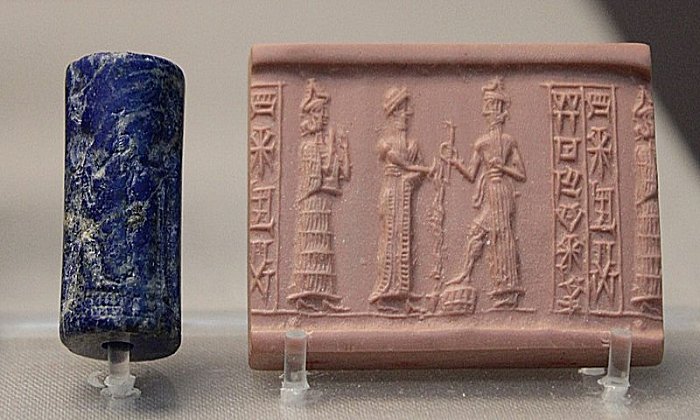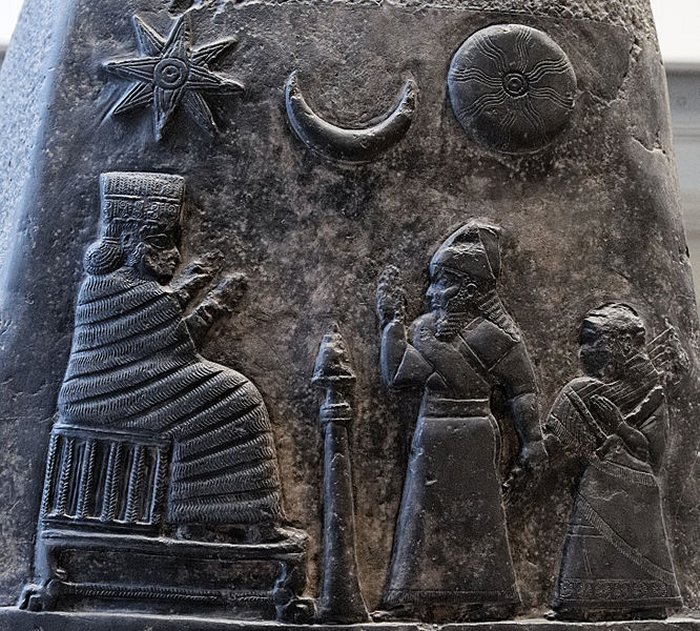Shamash: Mesopotamian God Of Sun, Truth, Justice And Healing
Ellen Lloyd - AncientPages.com - Shamash was the Sun god in the mythology of the ancient Near East. He was associated with truth, justice, and healing and was one of the most active gods in the pantheons of ancient Sumer, Babylonia, and Assyria. In Sumer, he was worshipped as god Utu.
Lapis lazuli cylinder seal. A suppliant goddess (left, with necklace counterweight) stands behind the robed king (center) who pours libation before the ascending sun god who holds the rod and ring of justice and rests his foot on a rectangular chequer-board mountain. Bur-Dagan, son of Kurub-Adad, inscribed on the seal, is probably the name of the owner. From a tomb in Ur, dated c. 1900 BC. BM 121418. Image credit: Zunkir - CC BY-SA 4.0
Shamash was the judge of gods and men
As a powerful solar deity, Shamash, whose consort was the goddess Aya, exercised the power of light over darkness and evil. In this capacity, he became known as the god of justice and equity and was the judge of both gods and men. At night, Shamash became the judge of the underworld.

Mesopotamian limestone cylinder seal and impression: worship of the sun god, Shamash, (Louvre Museum). Image credit: Jastrow - Public domain
Shamash was also regarded as a god who released sufferers from the grasp of demons. The sick appealed to Shamash as the god who can be depended upon to help those who are suffering unjustly. This aspect of Shamash is vividly brought out in hymns addressed to him.
In some cases, Shamash was seen as governing the entire universe and was pictured as a king on his royal throne with his staff and signet ring.
According to legend, the Babylonian king Hammurabi received his code of laws from Shamash.
The Hammurabi codes are some of the earliest and most complete ancient legal codes proclaimed by the Babylonian king Hammurabi, who reigned from 1792 to 1750 BC.
Shamash is depicted as overcoming darkness and death. In the Epic of Gilgamesh, he assisted in the conquest of the monster Humbaba, guardian of the deep forests of Lebanon.
Shamash worship and temples
Shamash was widely worshipped in the ancient near East. The chief centers of his cult were at Larsa, represented by the modern Senkerah in Sumer, and at Sippar, represented by the mounds at Abu Habba in Akkad.
Kudurru (stele) of King Melishipak I (1186–1172 BC): the king presents his daughter to the goddess Nannaya. The crescent moon represents the god Sin, the sun the Shamash and the star the goddess Ishtar. Image credit: Jastrow - Public domain
Temples dedicated to Shamash were also erected in all large population centers, including Babylon, Ur, Mari, Nippur, and Nineveh. Shamash's major temples were located at Sippar and Larsa.
In Canaanite tradition, the Sun god was Shemesh, the "torch of the gods," but was described as female. The worship of Shemesh/Shamash was also practiced among the Israelites, although it was forbidden by the prophets and biblical writers.
Shamash journey through the heavens in his chariot
Shamash, who was the brother of the goddess Ishtar, is often pictured with a disk that symbolizes the Sun. Like the later Apollo, he made his daily journey through the heavens, either on horseback, in a chariot, or on a boat. Together with Sin and Ishtar, Shamash formed a triad of gods that completed the even older trinity of Anu, Enlil, and Ea, representing the heavens, earth, and water, respectively. The three powers of Sin, Shamash, and Ishtar symbolized three great forces of nature: The sun, the moon, and the morning star (or love and fertility).
Tablet of Shamash
Shamash's symbol appears on numerous artifacts found in the Near East, including jewelry, cylinder seals, and other objects. One famous example, dating to the 9th century BCE and known simply as the "Tablet of Shamash", is currently housed in the British Museum.
Relief image on the Tablet of Shamash, British Library room 55. Found in Sippar (Tell Abu Habbah), in Ancient Babylonia; it dates from the 9th century BC and shows the sun god Shamash on the throne, in front of the Babylonian king Nabu-apla-iddina (888-855 BC) between two interceding deities. The text tells how the king made a new cultic statue for the god and gave privileges to his temple. Image credit: Prioryman - source
The Tablet of Shamash is a stone tablet recovered from the ancient Babylonian city of Sippar in southern Iraq in 1881. The tablet has serrated edges like a saw, which was the symbol of both Shamash and Saint Simon Zelotes in later traditions. The bas-relief on the top of the obverse shows Shamash, the Sun God, beneath symbols of the Sun, Moon, and Venus. He is depicted seated in a shrine, holding forward a measuring rod and reel of the cord. There is another large sun disk in front of him on an altar, suspended from above by two figures.
There is no doubt that Shamash was a very important deity in the Near East.
Updated on March 29, 2024
Written by Ellen Lloyd - AncientPages.com
Copyright © AncientPages.com All rights reserved. This material may not be published, broadcast, rewritten or redistributed in whole or part without the express written permission of AncientPages.com
Expand for referencesMore From Ancient Pages
-
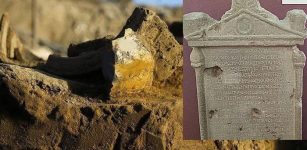 Lost Laodicea Temple And Seleucid Relics – Archaeological Search Continues
Archaeology | Jun 29, 2020
Lost Laodicea Temple And Seleucid Relics – Archaeological Search Continues
Archaeology | Jun 29, 2020 -
 Incredible Ancient Extinct World Of Unknown Organisms Discovered
Evolution | Jun 8, 2023
Incredible Ancient Extinct World Of Unknown Organisms Discovered
Evolution | Jun 8, 2023 -
 Problems With The Age Of Man And Theory Of Evolution – What Happened In The Past?
Featured Stories | Oct 11, 2021
Problems With The Age Of Man And Theory Of Evolution – What Happened In The Past?
Featured Stories | Oct 11, 2021 -
 Baffling Archaeological Find At George Washington’s Mount Vernon
Archaeology | Jun 20, 2024
Baffling Archaeological Find At George Washington’s Mount Vernon
Archaeology | Jun 20, 2024 -
 Two Huge Olmec Reliefs Recovered After Anonymous Tip
Archaeology | Aug 9, 2022
Two Huge Olmec Reliefs Recovered After Anonymous Tip
Archaeology | Aug 9, 2022 -
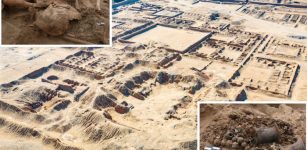 Ornaments And Human Remains Found In The Walled Complex Utzh An In Chan Chan, Peru
Archaeology | Jul 15, 2024
Ornaments And Human Remains Found In The Walled Complex Utzh An In Chan Chan, Peru
Archaeology | Jul 15, 2024 -
 Mysterious Relics Can Retrieve Leonardo da Vinci’s DNA And Provide New Information About The Great Renaissance Man
Archaeology | Apr 22, 2017
Mysterious Relics Can Retrieve Leonardo da Vinci’s DNA And Provide New Information About The Great Renaissance Man
Archaeology | Apr 22, 2017 -
 DNA Sheds Light On Ancient History Of Dogs All The Way To The Ice Age
Archaeology | Oct 30, 2020
DNA Sheds Light On Ancient History Of Dogs All The Way To The Ice Age
Archaeology | Oct 30, 2020 -
 How Did St. Nicholas Become Santa Claus? – History, Legend And Tradition
Featured Stories | Dec 22, 2023
How Did St. Nicholas Become Santa Claus? – History, Legend And Tradition
Featured Stories | Dec 22, 2023 -
 Unexplained Dangerous Secret In The Great Smoky Mountains
Featured Stories | Apr 20, 2024
Unexplained Dangerous Secret In The Great Smoky Mountains
Featured Stories | Apr 20, 2024 -
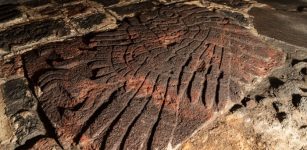 Huge Golden Eagle Relief Made By The Aztecs Discovered At Tenochtitlan
Archaeology | Feb 3, 2021
Huge Golden Eagle Relief Made By The Aztecs Discovered At Tenochtitlan
Archaeology | Feb 3, 2021 -
 The Brujo De Chiloé – The Wild Warlocks Of The Chiloé Archipelago
Featured Stories | May 4, 2022
The Brujo De Chiloé – The Wild Warlocks Of The Chiloé Archipelago
Featured Stories | May 4, 2022 -
 Ancient Warfare And Continuous Rise In Global Population – Is There A Connection?
Archaeology | Sep 13, 2021
Ancient Warfare And Continuous Rise In Global Population – Is There A Connection?
Archaeology | Sep 13, 2021 -
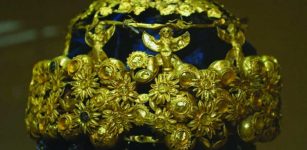 Long-Lost Mesopotamian Queen Hama Discovered By Student Just By Reading Books
Archaeology | Feb 14, 2019
Long-Lost Mesopotamian Queen Hama Discovered By Student Just By Reading Books
Archaeology | Feb 14, 2019 -
 Balkanatolia: Existence Of A Long-Forgotten Continent Discovered
Archaeology | Mar 1, 2022
Balkanatolia: Existence Of A Long-Forgotten Continent Discovered
Archaeology | Mar 1, 2022 -
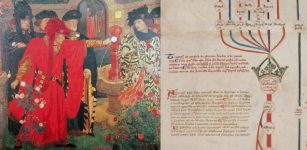 Unique Canterbury Roll – Ancient Manuscript Reveals Its Secrets About History Of England
Archaeology | Jan 5, 2018
Unique Canterbury Roll – Ancient Manuscript Reveals Its Secrets About History Of England
Archaeology | Jan 5, 2018 -
 Startling Discovery Of Nubian Levallois Technology In Shukbah Cave Re-Writes Ancient History Of Neanderthals And Homo Sapiens
Archaeology | Feb 24, 2021
Startling Discovery Of Nubian Levallois Technology In Shukbah Cave Re-Writes Ancient History Of Neanderthals And Homo Sapiens
Archaeology | Feb 24, 2021 -
 Jelling Stone And Legendary Harald ‘Bluetooth’ King Of Denmark – ‘Who Made The Danes Christian’
Vikings | Oct 10, 2015
Jelling Stone And Legendary Harald ‘Bluetooth’ King Of Denmark – ‘Who Made The Danes Christian’
Vikings | Oct 10, 2015 -
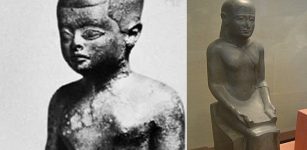 Imhotep: Ancient Genius And Architect Of The Sakkara Pyramid
Featured Stories | Mar 7, 2016
Imhotep: Ancient Genius And Architect Of The Sakkara Pyramid
Featured Stories | Mar 7, 2016 -
 Unique Ancient Man-Made Underground Structure In New England Puzzles Experts – Who Built It And Why?
Featured Stories | Aug 11, 2024
Unique Ancient Man-Made Underground Structure In New England Puzzles Experts – Who Built It And Why?
Featured Stories | Aug 11, 2024

